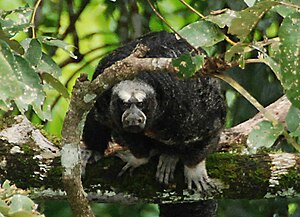Pithecia napensis
| Pithecia napensis | ||||||||||||
|---|---|---|---|---|---|---|---|---|---|---|---|---|

Pithecia napensis , male |
||||||||||||
| Systematics | ||||||||||||
|
||||||||||||
| Scientific name | ||||||||||||
| Pithecia napensis | ||||||||||||
| Lönnberg , 1938 |
Pithecia napensis (English: Napo Saki) is a primate species from the group of New World monkeys that occurs in the Ecuadorian Oriente regionsouth of the Río Napo and in the adjacentregion of Peru north of the Río Marañón .
features
Pithecia napensis reaches a total length of about 85 cm, the tail has a length of 44 to 48 cm. The males are blackish in color with light hair tips, which creates a somewhat grayish impression. The face is whitish above the eyes, greyish below. The hairless skin on the nose and around the mouth is black, in some specimens also rosy. The chest is rusty or orange in color. Females are more of a dark grayish color with brown chest hair and usually have darker faces. In both sexes, the tops of the hands and feet are covered with short white hair. White eyebrow spots above the eyes are characteristic of the species, a feature that Pithecia napensis shares with Pithecia isabela from northeastern Peru. In Pithecia napensis, however, the spots are much closer together and converge far over the forehead and increasingly grayish also on the face, while in Pithecia isabela they are much smaller and more diffuse and do not extend to the face. Pithecia napensis appears bulkier and larger and the males have a lighter, more orange-appearing breast, while the breasts of the males of Pithecia isabela are more orange-brown.
Systematics
The shape was described in 1938 by the Swedish zoologist Einar Lönnberg as a subspecies of the monk monkey ( Pithecia monachus ), but in 1987 it was withdrawn by Philip Hershkovitz and synonymous with Pithecia monachus . It was not until 2014, in a revision of the Sakis , that Pithecia napensis was recognized as an independent species.
literature
- Laura K. Marsh. 2014. A Taxonomic Revision of the Saki Monkeys, Pithecia Desmarest, 1804. Neotropical Primates. 21 (1); 1–163, pages 69 to 74.